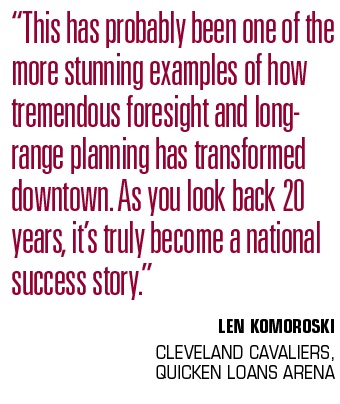It’s hockey night in Boston and the revamped Legends Club is brimming with activity at TD Garden, 90 minutes before the hometown Bruins face off against the Florida Panthers.
Bruins and Celtics season-ticket holders get exclusive access to this premium space after an offseason retrofit expanded the event-level club and gave it a fresh look.
The club’s technology includes projection screens that flash 3-D-like images replicating the teams’ championship banners. Structural columns contain slow-motion video of Bruins legend Cam Neely making his way across the ice.
The iconic Boston Garden marquee lines the back wall as fans sporting Bruins jerseys dine on an upgraded menu featuring a seafood tower, oven-fired pizzas, and a monstrous gelato banana split dubbed the Kitchen Sink.
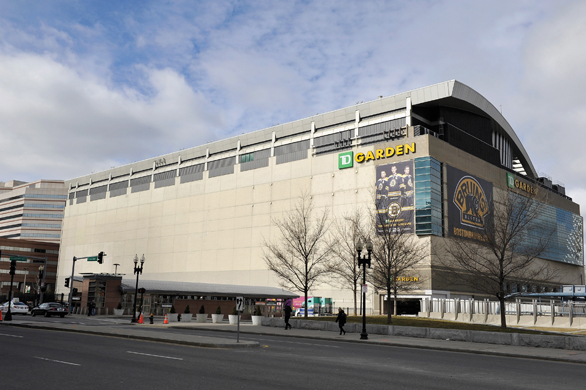 |
A $70 million renovation at Boston’s TD Garden includes a revamped Legends Club (below).
Photo by: Getty Images |
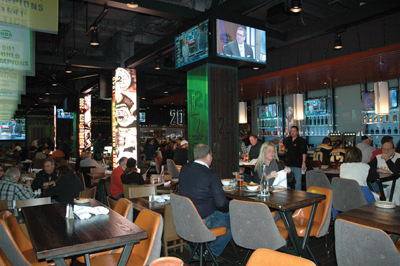 |
| Photo by: Don Muret / Staff |
Legends is the centerpiece of a $70 million renovation of TD Garden, which turns 20 years old next year. It’s one of six NBA and NHL facilities celebrating two decades of existence spanning 2014 through 2015.
In addition to Boston, arenas in Chicago, Cleveland, St. Louis, Portland and Vancouver formed the first wave of new sports development in the 1990s.
Renovations such as those just finished at TD Garden, where Delaware North has poured in $130 million over the past eight years, have helped the venues keep pace with newer arenas, but these six facilities are about much more than keeping up with the Joneses. As the facilities redefine themselves, they’re influencing arenas half their age, offering ideas for how they could do upgrades of their own. Some serve as anchors for redeveloping their cities’ inner core. They all plan to be around for years to come.
In Chicago, for example, the Bulls and Blackhawks have invested $80 million to improve United Center since it opened in 1994. They are now discussing ways to expand the arena’s footprint to include a more accessible team store. Arena executives see a facility they feel will endure — and prosper.
“I think we have barely scratched the surface of what the life of this building is going to be,” said Terry Savarise, United Center’s senior vice president of operations, who turns 55 on Thursday. “It’s going to way outlast me.”
New spins on old space
Over the past 20 years, the six arenas have seen a multitude of changes and improvements, extending from the names of the buildings themselves to the seat colors inside the facilities.
Three arenas opened without naming rights — Gund Arena, Kiel Center and the Rose Garden. All three now have
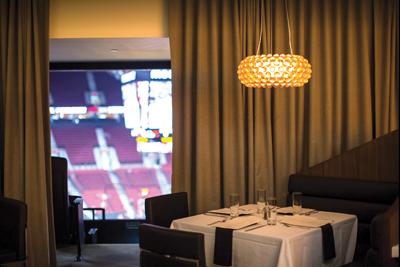 |
Moda Center recently completed $16 million in upgrades, renovating suites and consolidating others into smaller studio suites (shown).
Photo by: Portland Trail Blazers |
deals in place. Portland went 17 years without naming rights before being renamed Moda Center last year.
United Center is the only one to keep the name it opened with 20 years ago. Last year, the arena renewed its deal with United Airlines for another 20 years. The extension carries an annual value of $11 million, a big jump over the original agreement’s value of $2 million a year.
Scottrade Center opened originally as the Kiel Center. One of the first changes the arena made was replacing the original fuchsia seats that had been selected by arena developer and ex-Disney executive Jud Perkins. In 1996, only two years after the arena opened, blue seats were installed and the yellow handrails painted blue to match the Blues hockey team color.
The old Gund Arena underwent a dramatic transformation after Dan Gilbert bought the Cavaliers in 2005. Over the past 10 seasons, the team has invested about $70 million alone in arena upgrades, said Len Komoroski, president of the Cavaliers and the arena. The arena’s old powder blue seats were one of the first things Gilbert had replaced after going back to the team’s original wine-and-gold color scheme. It cost $3 million to make the change.
“The powder blue seats were not our best presentation,” Komoroski said. “Even though the seats were perfectly fine, the whole tenor and feel of the building changed [with wine-colored seats]. It felt like a new arena when you walked in.”
Seat color aside, the biggest physical changes in these arenas have come mostly in the premium seat category. In the early to mid ’90s, premium options were restricted to a traditional corporate suite accommodating 12 to 16 people and a club seat product tied to a hospitality lounge.
As suite leases expired and market demands shifted, teams found themselves with empty skyboxes, especially behind the endzones, forcing them to get creative and develop new and smaller premium seat options to fit the needs of a changing corporate culture.
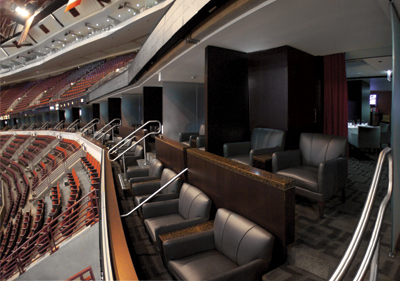 |
United Center took excess suite inventory and converted it into four-seat theater boxes that share dining space.
Photo by: Chicago Bulls |
United Center, at 980,000 square feet, opened with a whopping 216 suites during the Michael Jordan era and all were pre-sold to pay that debt, Savarise said. The total number surpassed the 180 suites at the Pistons’ Palace of Auburn Hills, the arena visited most by the Chicago teams to get ideas for their building.
Over the past two decades, the number has dwindled to about 150 traditional suites as arena officials repurposed unsold units on the second and third suite levels and created the all-inclusive BMO Harris Club and four-seat theater boxes with shared dining space.
Five years after the 32 theater boxes, which were inspired by opera boxes at European venues, made their debut in Chicago, smaller groups of premium seats are still trending in the NBA and NHL. TD Garden has its own version of the theater box, the four-seat lofts that used to be full-fledged suites. Wells Fargo Center officials recently toured TD Garden to get ideas for upgrading their 18-year-old arena in Philadelphia.
Moda Center most recently adopted a similar “rightsizing” design. Soon after Chris McGowan arrived in Portland as president of the Blazers, he recognized the need to shake things up on the premium level.
The Blazers recently completed $16 million in upgrades, renovating suites and consolidating others into smaller studio suites. Club lounges were upgraded and the food is now tied to stored-value tickets. An old outdoor smoking space became “The Pines,” a new indoor bar in the upper deck.
Two years ago, when McGowan first took over as Blazers president, the arena’s 66 suites were identical, something McGowan had never seen before, he told the audience last summer at an industry conference.
Plus, all the suites were originally sold on nine-year terms, said Chris Oxley, the team’s general manager of Rose Quarter operations. That runs counter to the typical staggered terms, used to relieve the pressure of having to renew everything at once.
For this season, Moda Center’s total number of traditional suites has been cut to about 50 after consolidating some units and developing the new studio suites. The four-seat, all-inclusive boxes sell for $55,000 annually and all 12 are sold out for this season.
“We still need to do a lot in our building,” McGowan said. “We have an owner [Paul Allen] that’s worth [$17] billion, and if you go try to ask for public money, it becomes a little bit of a challenge. At some point, I would hope there would be access to funds to help do some of the bigger stuff.”
St. Louis is next for major arena improvements, as the Blues huddle with architects and financial analysts to form a master plan for long-term improvements throughout the building. The Blues have already played a role for resurrecting the historic Peabody Opera House next door to the arena, a theater that sat vacant for 20 years until it was renovated and reopened in 2011. Team owner Tom Stillman co-owns the Peabody, and the team uses separate ballroom space inside the venue for team events.
Changing the neighborhood
The arenas turning 20 years old have evolved over time to meet the changes in fan behavior and their spending habits. Years later, the evolution extends beyond the arena walls in some of those markets.
The neighborhoods in which the arenas reside have changed for the better in Cleveland, Chicago and Boston. It’s taken time, but the results are evident.
At the time Gund Arena opened in 1994, named after former Cavaliers owner Gordon Gund, an adult bookstore sat directly across the street. There were a few restaurants and assorted hat shops, but no residential units and no hotels in a neglected part of the city.
“It was basically a seedy part of town, and when I say seedy, I’m being kind,” Komoroski said. “It was probably the most blighted area of downtown.”
The effort to revive the Gateway District, the section of downtown that’s home to the arena, Progressive Field and other entertainment venues, started in the early 1990s when the Cleveland Indians launched their effort to build a new ballpark.
Political leaders developed a plan to levy a “sin tax” on the sale of alcohol and tobacco products to fund stadium construction but needed another element to “propel it positively in the polls” as it came to a public vote, Komoroski said. They persuaded Gund to move the Cavs downtown and an arena project was added to the ballot. The tax measure passed by the slimmest of margins, but it’s just a historical footnote now. Building the arena and the ballpark helped turn things around in an area “ripe to do something big and catalytic,” Komoroski said.
Twenty years later, the adult bookstore is long gone. More than $700 million in related development has taken root in the Gateway District. In addition to the sports venues, nine hotels, a casino and the House of Blues, among other attractions, were built within a few blocks of the arena. Of the city’s 11 million annual visitors, 9 million attend events in the district within a one-block radius of the arena, Komoroski said.
Clevelanders took notice of the district’s resurrection. Earlier this year, a solid 57 percent of local voters approved an extension of the tax to help fund renovations to the arena, ballpark and First Energy Stadium, home of the Cleveland Browns.
Using those tax dollars to buy a new video board, the NBA’s largest center-hung board, helped Cleveland win the 2016 Republican National Convention, Komoroski said.
“This has probably been one of the more stunning examples of how tremendous foresight and long-range planning has transformed downtown,” he said. “As you look back 20 years, it’s truly become a national success story.”
In Chicago and Boston, public dollars were not available to pay for arena construction and the teams privately financed those projects. The clubs have subsequently dug into their own pockets to help rebuild the neighborhoods around their arenas.
United Center sits west of downtown, 18 blocks from the heart of Chicago’s business district. Twenty years ago, when the arena first opened, the neighborhood was known more for its proximity to Skid Row than an area primed for a rebirth.
“It was dangerous down there,” said Bulls President Michael Reinsdorf. “It was not an area you wanted to be in. There were times when people would wave you in to park on the street and watch your car for you [in exchange for cash]. You got nervous.”
Two years after United Center opened, though, the 1996 Democratic National Convention came to the city and the arena. It proved to be a game changer for West Side redevelopment, Reinsdorf said.
Mayor Richard M. Daley, intent on washing clean the stains of the Grant Park riots tied to the 1968 DNC under his father’s administration, knocked down old buildings and parking lots and spruced up the neighborhood with landscaping and fencing.
“It changed some perceptions of the West Side and got some developers thinking about opportunities near the arena,” Reinsdorf said.
Fast forward to 2014 and that 18-block stretch of Madison Street heading east to downtown Chicago has filled in nicely with bars, restaurants and townhouses, plus Advocate Center, the Bulls’ new practice facility that opened in September. On nights after hockey games, a sea of red, fans wearing Blackhawks jerseys, can be seen walking to those establishments.
“Having done a lot of these projects, I never was a believer that a sports facility is going to be the direct cause for urban renewal,” Savarise said. “But I do believe they can accelerate something that’s going to happen. I think the United Center is a perfect example of that.”
Big moves in Beantown
In Boston, recent developments are filling up vacant lots. There’s a “Now Leasing” sign attached to the new Victor Apartments complex across the street from TD Garden. The 286-unit building features an indoor basketball court.
Across Interstate 93, facing the arena’s east side, Converse is building its new global headquarters after moving
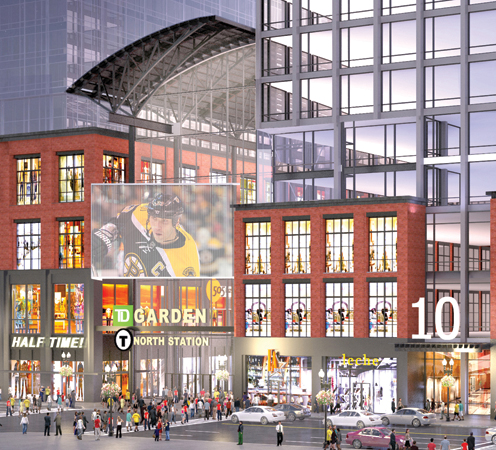 |
The TD Towers project will include a new entrance for TD Garden.
Photo by: Delaware North |
from Andover, a Boston suburb. It opens in April as part of the Lovejoy Wharf project adjacent to the city’s North End neighborhood.
Those two developments are just a preview of what’s to come over the next three years: the massive $950 million TD Towers project, financed by Delaware North, owner of the Bruins and the arena, and Boston Properties, its partner in the development.
Three towers flanking the arena will bring a new hotel in addition to retail, residential and office space, and a full-service supermarket sorely needed in the neighborhood, said TD Garden President Amy Latimer.
As part of TD Garden Towers, the arena could expand outward on the south side by about 45,000 square feet, and a new front door is planned for the facility, which is built above a major transit station. In a tight footprint, having a true main entrance is something Latimer has desperately wanted ever since the arena opened in 1995.
The towers project will break ground in mid-2015, said Charlie Jacobs, a principal with Delaware North and the Bruins.
“This is a new little energy spot here in the city,” Latimer said. “The combination of what started the transformation and what we’re going to do with the front [of the arena] development will be phenomenal.”






